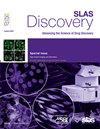ATPase activity profiling of three human DExD/H-box RNA helicases
IF 2.7
4区 生物学
Q2 BIOCHEMICAL RESEARCH METHODS
引用次数: 0
Abstract
Human DExD/H-box RNA helicases are ubiquitous molecular motors that unwind and rearrange RNA secondary structures in an ATP-dependent manner. These enzymes play essential roles in nearly all aspects of RNA metabolism. While their biological functions are well-characterized, the kinetic mechanisms remain relatively understudied in vitro. In this study, we describe the development and optimization of a bioluminescence-based assay to characterize the ATPase activity of three human RNA helicases: MDA5, LGP2, and DDX1. The assays were conducted using annealed 24-mer ds-RNA (blunt-ended double-stranded RNA) or double-stranded RNA with a 25-nt 3ʹ overhang (partial ds-RNA). These findings establish a robust and high-throughput in vitro assay suitable for a 384-well format, enabling the discovery and characterization of inhibitors targeting MDA5, LGP2, and DDX1. This work provides a valuable resource for advancing our understanding of these helicases and their therapeutic potential in Alzheimer's disease.
三种人DExD/H-box RNA解旋酶的atp酶活性分析。
人类DExD/H-box RNA解旋酶是普遍存在的分子马达,以atp依赖的方式解开和重排RNA二级结构。这些酶在RNA代谢的几乎所有方面起着至关重要的作用。虽然它们的生物学功能已经被很好地表征,但在体外的动力学机制研究仍然相对不足。在这项研究中,我们描述了一种基于生物发光的测定方法的开发和优化,以表征三种人类RNA解旋酶:MDA5, LGP2和DDX1的atp酶活性。检测使用退火的24-mer ds-RNA(钝端双链RNA)或25-nt 3'悬垂双链RNA (ds-RNA)进行。这些发现建立了一个强大的、高通量的体外检测方法,适用于384孔格式,能够发现和表征靶向MDA5、LGP2和DDX1的抑制剂。这项工作为我们进一步了解这些解旋酶及其在阿尔茨海默病中的治疗潜力提供了宝贵的资源。
本文章由计算机程序翻译,如有差异,请以英文原文为准。
求助全文
约1分钟内获得全文
求助全文
来源期刊

SLAS Discovery
Chemistry-Analytical Chemistry
CiteScore
7.00
自引率
3.20%
发文量
58
审稿时长
39 days
期刊介绍:
Advancing Life Sciences R&D: SLAS Discovery reports how scientists develop and utilize novel technologies and/or approaches to provide and characterize chemical and biological tools to understand and treat human disease.
SLAS Discovery is a peer-reviewed journal that publishes scientific reports that enable and improve target validation, evaluate current drug discovery technologies, provide novel research tools, and incorporate research approaches that enhance depth of knowledge and drug discovery success.
SLAS Discovery emphasizes scientific and technical advances in target identification/validation (including chemical probes, RNA silencing, gene editing technologies); biomarker discovery; assay development; virtual, medium- or high-throughput screening (biochemical and biological, biophysical, phenotypic, toxicological, ADME); lead generation/optimization; chemical biology; and informatics (data analysis, image analysis, statistics, bio- and chemo-informatics). Review articles on target biology, new paradigms in drug discovery and advances in drug discovery technologies.
SLAS Discovery is of particular interest to those involved in analytical chemistry, applied microbiology, automation, biochemistry, bioengineering, biomedical optics, biotechnology, bioinformatics, cell biology, DNA science and technology, genetics, information technology, medicinal chemistry, molecular biology, natural products chemistry, organic chemistry, pharmacology, spectroscopy, and toxicology.
SLAS Discovery is a member of the Committee on Publication Ethics (COPE) and was published previously (1996-2016) as the Journal of Biomolecular Screening (JBS).
 求助内容:
求助内容: 应助结果提醒方式:
应助结果提醒方式:


